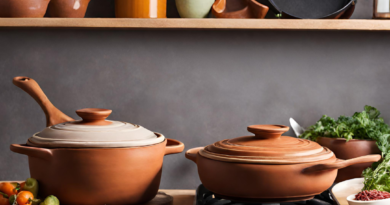Can clay pots be used in modern ovens and stovetops?
Clay pots, while steeped in tradition, can indeed find a comfortable place in modern kitchens, including the use of ovens and stovetops. Their versatility and unique cooking properties make them a valuable addition to your cookware collection. In this article, we’ll explore the compatibility of clay pots with modern ovens and stovetops and offer guidance on how to use them effectively.
1. Oven Use:
a. Conventional Ovens: Clay pots, such as tagines, cazuelas, and Romertopfs, are compatible with conventional ovens. They can withstand the moderate temperatures typically used in baking, roasting, and slow-cooking. When using a clay pot in the oven, it’s important to preheat the oven gradually to prevent thermal shock to the clay.
b. Temperature Considerations: Clay pots are best suited for cooking at low to medium temperatures, generally up to around 500°F (260°C). Avoid using them in extremely high-temperature settings or broiling, as this can lead to rapid and uneven heating, potentially causing the clay to crack.
c. Oven-Roasting: Clay pots are excellent for roasting meats and vegetables. They provide even heat distribution and moisture retention, resulting in tender and flavorful dishes.
d. Baking: Clay pots can be used for baking bread, casseroles, and other baked goods. Their porous nature helps create a delightful, crispy crust on bread while keeping the interior moist.
2. Stovetop Use:
a. Compatibility with Gas Stovetops: Some clay pots can be used on gas stovetops with a diffuser or heat diffusing plate. This plate helps distribute heat evenly and reduces the risk of direct contact between the clay and open flames. However, it’s essential to follow the manufacturer’s recommendations for your specific clay pot.
b. Electric Coil and Induction Stovetops: Most clay pots are not suitable for direct use on electric coil or induction stovetops because they require a flat, smooth surface for proper heat conduction. Attempting to use clay pots on these stovetops without a diffuser can result in cracking.
c. Clay Pot Adapters: In some cases, you can find clay pot adapters or diffusers designed for electric stovetops. These adapters help distribute heat evenly and protect the clay pot from direct contact with the heating element.
3. Precautions:
When using clay pots on stovetops or in ovens, keep the following precautions in mind:
– Avoid Rapid Temperature Changes:** Gradually increase or decrease the heat to prevent thermal shock, which can lead to cracking.
– Use Proper Cookware: Ensure that the clay pot is designed for stovetop or oven use. Some clay pots are intended solely for serving and should not be exposed to direct heat.
– Inspect for Cracks: Before each use, inspect your clay pot for any cracks or damage. Using a damaged clay pot can be unsafe and may result in further cracking.
– Follow Manufacturer Guidelines: Always follow the manufacturer’s recommendations and instructions for your specific clay pot. Different types of clay pots may have varying heat tolerances.
– Soaking: If you haven’t used your clay pot for a while, soak it in water for 15-30 minutes before use to prevent moisture absorption during cooking.
In conclusion, clay pots can be used effectively in modern ovens and, with proper precautions and, in some cases, the use of diffusers, on certain stovetops. Their ability to distribute heat evenly and retain moisture makes them a versatile and valuable addition to any kitchen, whether your culinary style is rooted in tradition or inspired by modern cooking techniques.



